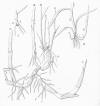WILD
FOODIES' HOME PAGE
PLANT PROFILE LIST
NAME: Reedgrass
SPECIES / FAMILY: Phragmites Australis / Poaceae or Gramineae
OTHER COMMON NAME(S): common reed, wild broomcorn
CONDITIONS: sun,
marsh
|
PARTS: |
EDIBLE |
TASTE |
RAW/COOK |
SEASON |
|
All |
|
|
|
|
|
Shoots |
|
sweet |
RAW/COOK |
Spring |
|
Leaves |
|
|||
|
Stalk/Stem |
|
sweet/liquorice |
RAW/COOK |
Summer |
|
Buds |
||||
|
Flowers |
|
|
|
|
|
Fruits |
|
|
|
|
|
Pods |
|
|||
|
Seeds |
|
|
RAW/COOK |
Summer/Fall |
|
Nuts |
|
|
|
|
|
Roots |
best young |
|
RAW/COOK |
Fall |
|
Bark |
|
|
|
|
PORTION: medium
COMMENT: Sweetener. Root - It contains up to 5% sugar. Raw, cook like potato, or dried, ground coarsely and used as porridge. Young shoots - best if used before leaves form, really delicious, used like bamboo shoots. Unfolded leaves used as potherb. Japanese dry young leaves, grind them into a powder and mix them with cereal flour when making dumplings. Seed - ground into a powder and used as a flour, very nutritious. Sugar is extracted from the stalks or wounded stems, sweet liquorice-like taste. The stems can be boiled in water and then the water boiled off in order to obtain the sugar. A sugary gum that exudes from the stems can be rolled into balls and eaten as sweets. A powder extracted from the dried stems can be moistened and roasted like marshmallow.(1)
CAUTION: Avoid polluted waters and cook water plants to kill any bacteria or other water-born parasites.
NUTRITION/MEDICINAL: The stems are reported to contain 4.8 g protein, 0.8 g fat, 90.0 g total carbohydrate, 41.2 g fiber, and 4.4 g ash.(1) Antiasthmatic; Antidote; Antiemetic; Antitussive; Depurative; Diuretic; Febrifuge; Lithontripic; Miscellany; Refrigerant; Sialagogue; Stomachic; Styptic. (1) The Paiute used common reedís sugary sap to treat lung ailments. The Apache used its rhizomes to treat diarrhea, stomach troubles, earaches, and toothaches.(2)
LOOK-A-LIKES:
POISONOUS LOOK-A-LIKES: Yellow Flag Iris, Blue Flag Iris
OTHER USES: Basketry; Biomass; Broom; Cork; Dye; Fibre; Fuel; Furniture; Insulation; Miscellany; Paper; Pencil; Soil stabilization; Thatching; Weaving. (1)
SOURCE LINKS (may include nutritional and medicinal info, plus other uses):
1. https://pfaf.org/User/Plant.aspx?LatinName=Phragmites+australis
2. http://www.eattheweeds.com/common-reed
3. https://en.wikipedia.org/wiki/Phragmites
4.
http://www.survivallandusa.com/Phragmites-Communis-Australis-Reed-Grass-Edible.html
(good photos)
https://commons.wikimedia.org/wiki/Phragmites_australis#/media/File:Phragmites_australis_rhizome_kz.jpg

_small.jpg)

